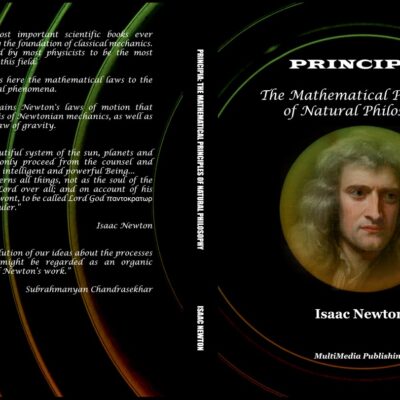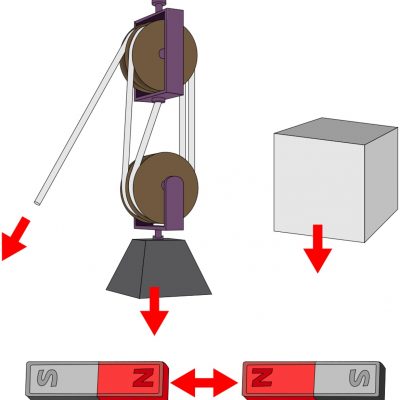 (Arabic manuscript about a machine. Unknown date (estimated: 16th-19th centuries).
(Arabic manuscript about a machine. Unknown date (estimated: 16th-19th centuries).
Mechanics is a branch of physics whose object is the study of motion, deformations or equilibrium states of physical systems. This science aims to describe the movements of different kinds of bodies, from subatomic particles with quantum mechanics, to galaxies with celestial mechanics.
Until the nineteenth century, the notion of mechanics encompassed both the scientific study of moving bodies and the theory of machines. In the twenty-first century, while mechanics as a science does not lose sight of the question of its practical application, it is no longer essentially an activity aimed at designing machines.
History
The foundations of mechanics, as a science and in the modern sense of the word, are posited by Galileo. It is then not dissociated from the mechanical arts, that is to say techniques of construction of the machines. In 1559, the word thus designates “the part of mathematics whose object is the knowledge of the laws of motion and the theory of the action of machines”. A little later will be called mechanic (attested in 1696) the person who “possesses the science of mechanics and the one who invents, calculates, builds machines”. It is only in the nineteenth century, from 1840, that this term means “the one who raises and maintains machines”, and that the distinction is made more clearly between mechanics as a science and mechanics as a technique.
If the word appears in the Renaissance in its modern sense, however, this science has its roots in much older times and its history is inseparable from astronomy.
Originally, mechanics, which does not yet bear this name, includes reflections, still philosophical or religious, aimed in particular to explain the movements of the stars. The regularity of the movements of celestial objects does not escape the first astronomers, who then conceive the sky and its mobiles as a kind of gigantic machine.
The contributions of Archimedes to the construction of a mechanical science, then still in the making, are absolutely fundamental. It is in particular from his reflections on the balance of bodies that Galileo will lay the foundations of modern mechanics. It is not yet a theory of motion, but a static mechanics, that is, a science aimed at understanding the arrangement of bodies at rest.
It is Aristotle who will lay the first foundations of a real mechanical theory. According to him, all the bodies of the universe derive the origin of their movement from a first motor, the movements being transmitted by contact. Added to this is the idea that objects move to reach the proper place for them, where they will find immobility.
Aristotle’s theory of movement has many difficulties of which the Stagirite was well aware. One of the most important was the movement of the arrow, which was not understood by what it could be worn after being launched by the archer. Aristotle’s ideas, however, will largely dominate the way of conceiving the movement until the beginning of the second millennium, in the absence of a truly credible alternative theory. It will be necessary to wait for the theory of the impetus.
The notion of impetus aims in particular to respond to the aporias of Aristotle’s theory. The impetus is a kind of kinetic power that is consumed and exhausted as a body moves. Although intuitively close enough to the notion of kinetic energy, the impetus was in fact very distant, because it continued to carry the idea of absolute movement (and thus the idea of a possible absolute immobility). In this theory, there is a difference of nature between the moving object, carrying a certain impetus, and the immobile object, without impetus. It is necessary to wait for Galileo to overcome these erroneous conceptions of the movement.
Based on the achievements of Galileo then Newton, classical mechanics can rely on different formalisms, especially those of the analytical mechanics. The notions of Lagrangian or Hamiltonian play a fundamental role.
At the beginning of the twentieth century, and while classical mechanics seems to be an unshakable edifice, two theories come to radically challenge it: quantum mechanics and relativistic mechanics.
The main fields of mechanics
(MIT Prof. Walter Lewin explains Newton’s law of universal gravitation)
Newtonian mechanics is a branch of physics. Since the work of Albert Einstein, it is often described as classical mechanics. It is perfectly suited to “everyday” questions, but has limits for extreme cases (for example for speeds close to the speed of light, for extremely massive objects such as black holes, interactions at atomic and subatomic scale, etc.).
To simplify, relativistic mechanics modifies classical mechanics, by correctly managing velocities close to those of light (contrary to classical mechanics), and by forbidding velocities superior to light (which are theoretically possible in mechanics classic).
Quantum mechanics makes it possible to explain, on the atomic and subatomic scale, the phenomena that can not be explained by classical mechanics, such as black body radiation, the photoelectric effect, or the existence of spectral lines.
The main principles of mechanics
Principle of energy conservation: For any physical object having a mass, any modification of its state involves an expense or dissipation of energy.
Principle of least action: The idea of the principle of least action is that any change (direction, speed, etc.) will be achieved by transferring the least energy possible from one system to another, to achieve the change in question. In other words, this change will be the one that will transfer the least energy among all the possible changes (principle of least action), and this change will not transfer more energy than is strictly necessary (first principle of thermodynamics), if we neglect losses due to friction, energy conversion, etc. (second principle of thermodynamics).








Leave a Reply